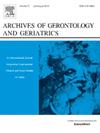微量营养素与肌肉减少症之间的因果关系:一项双样本双向孟德尔随机化研究
IF 3.8
3区 医学
Q2 GERIATRICS & GERONTOLOGY
引用次数: 0
摘要
骨骼肌减少症是老年人的一种老年综合症,严重影响生活质量并增加健康风险。本研究利用基于全基因组关联研究(GWAS)的孟德尔随机化(MR)研究了特定微量营养素(镁、硒、钙、锌、铁、磷和omega-3脂肪酸)与肌少症相关性状(sp -性状)之间的因果关系。使用来自14个GWAS的数据进行双向双样本MR分析,重点关注5个sp特征:低握力、中高强度体力活动(MVPA)、无辅助步行或骑车10分钟的能力(AWCU10)、正常步行速度和调整后的尾肢瘦质量(ALM)。该分析确定了14个与锌水平和MVPA相关的单核苷酸多态性(snp),以及12个与正常步行速度相关的snp。在ALM中,72个snp与镁相关,81个与omega-3脂肪酸相关。锌水平与MVPA (β = 0.85, P = 0.026)和通常步行速度(β = 0.53, P = 0.008)之间存在显著相关性。反向MR分析显示ALM与镁呈正相关(beta = 0.126, P = 0.0004),与omega-3呈名义显著负相关(beta = -0.083, P = 0.008)。虽然注意到一些异质性,但未发现多效性,从而加强了研究结果的稳健性。这项研究强调了镁、锌和omega-3脂肪酸对肌肉健康的重要性,并倡导将其纳入公共卫生战略,以增强老年人的身体功能和生活质量。需要进一步的研究来验证这些发现在不同人群中的有效性。本文章由计算机程序翻译,如有差异,请以英文原文为准。
Causal relationships between micronutrients and sarcopenia: a two-sample bidirectional Mendelian randomization study
Sarcopenia, a geriatric syndrome in older adults, significantly impacts quality of life and elevates health risks. This study examines the causal relationships between specific micronutrients—magnesium, selenium, calcium, zinc, iron, phosphorus, and omega-3 fatty acids—and sarcopenia-related traits (SP-traits) using Mendelian randomization (MR) based on genome-wide association studies (GWAS). A bidirectional two-sample MR analysis was performed using data from fourteen GWAS, focusing on five SP-traits: low hand grip strength, moderate-to-vigorous physical activity (MVPA), ability to walk or cycle unaided for 10 min (AWCU10), usual walking pace, and adjusted appendicular lean mass (ALM). The analysis identified 14 single nucleotide polymorphisms (SNPs) linked to zinc levels and MVPA, and 12 SNPs associated with usual walking pace. Concerning ALM, 72 SNPs were associated with magnesium and 81 with omega-3 fatty acids. Significant associations were noted between zinc levels and MVPA (beta = 0.85, P = 0.026) and usual walking pace (beta = 0.53, P = 0.008). The reverse MR analysis revealed a positive correlation between ALM and magnesium (beta = 0.126, P = 0.0004) and a nominally significant negative correlation with omega-3 (beta = -0.083, P = 0.008). While some heterogeneity was noted, no pleiotropy was detected, reinforcing the robustness of the findings. This study highlights the importance of magnesium, zinc, and omega-3 fatty acids in muscle health and advocates for their inclusion in public health strategies to enhance the physical function and quality of life in older adults. Further research is needed to validate these findings across diverse populations.
求助全文
通过发布文献求助,成功后即可免费获取论文全文。
去求助
来源期刊
CiteScore
7.30
自引率
5.00%
发文量
198
审稿时长
16 days
期刊介绍:
Archives of Gerontology and Geriatrics provides a medium for the publication of papers from the fields of experimental gerontology and clinical and social geriatrics. The principal aim of the journal is to facilitate the exchange of information between specialists in these three fields of gerontological research. Experimental papers dealing with the basic mechanisms of aging at molecular, cellular, tissue or organ levels will be published.
Clinical papers will be accepted if they provide sufficiently new information or are of fundamental importance for the knowledge of human aging. Purely descriptive clinical papers will be accepted only if the results permit further interpretation. Papers dealing with anti-aging pharmacological preparations in humans are welcome. Papers on the social aspects of geriatrics will be accepted if they are of general interest regarding the epidemiology of aging and the efficiency and working methods of the social organizations for the health care of the elderly.

 求助内容:
求助内容: 应助结果提醒方式:
应助结果提醒方式:


